Eliminating flying black bugs in your house can be challenging if you don’t know what you are dealing with. Aside from being very small, these notorious pests have some similarities in physical appearance and behavior. Note also that some of them are beneficial to gardens and lawns, so control may not be required.
The key to getting rid of black bugs with wings inside your house is to find their habitat and destroy it. Removing all their food sources is also a must. Some insecticides can help, too. Preventive measures include sanitation and blocking their potential entry points.
There are many different bugs that can invade your house. Some of them can cause an infestation before you know it. Therefore, learning to identify the bugs inside your house is very important. In this article, you will learn the habitat, diet, and threat of common house bugs, along with some recommended insecticides.
Table of Contents
What Are the Common Black Bugs With Wings in Your House?
Black bugs come in different sizes, although most of them are very small. Some are great flyers, while others fly only at a short distance. Some insects also bite and can carry diseases, while some are totally harmless but very destructive. Here are the common flying black bugs that can enter your house:
- Houseflies
- Beetles
- Minute Pirate Bugs
- No-See-Ums
- Flying Termites
- Fungus Gnats
- Drain Flies
- Flying Ants
- Fruit Flies
- Phorid Flies
Identification of Black Bugs With Wings
1. Houseflies
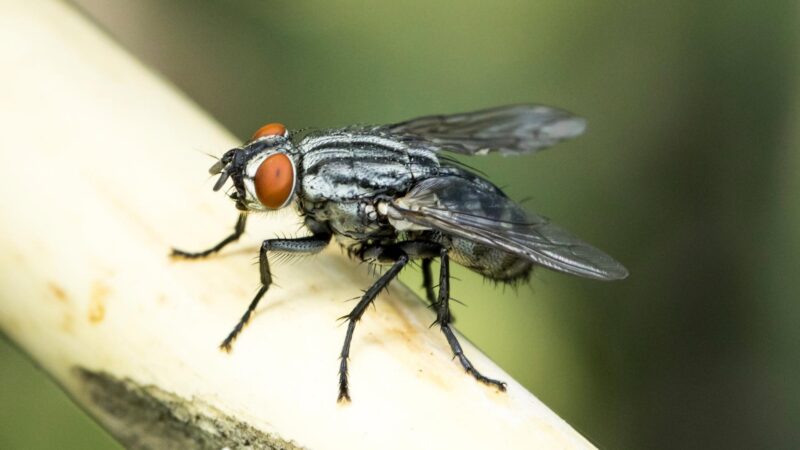
Scientific Name
The scientific name of houseflies is Musca domestica. These cosmopolitan pests belong to the family Muscidae, in the insect suborder Cyclorrhapha. Being the most common fly species in the world, houseflies are found on every continent except Antarctica. They can adapt to any kind of climate but hide during winter.
Lifespan
Fly eggs hatch within 8-20 hours, while larvae (maggots) develop into pupae between 4 and 30 days, depending on the temperature. Adults usually live between 15 and 25 days but will die in 3 days without food. The average life cycle of houseflies is 7 to 10 days but can reach up to 2 months under suboptimal conditions.
Habitat
Houseflies live in urban and rural areas and can adapt well to human habitats. They are usually found in garbage, human waste, animal feces, and other unsanitized locations. Inside the house, these filthy insects prefer staying in warm, wet areas with food sources. This includes the kitchen and bathrooms.
Diet
Houseflies eat decaying organic matter such as human food, including cooked or uncooked food, fruits, vegetables, and kitchen waste. Adults also feed on blood and feces, while larvae mostly feed on cotton, paper, wool, and other textile materials. Nevertheless, water plays a huge part in their diet and reproduction.
Threat
Houseflies don’t bite or sting humans. But since they breed on human and animal feces, houseflies can easily transfer bacteria to human food through their poop and vomit. Among the diseases that houseflies can transmit are anthrax, cholera, dysentery, E. coli, leprosy, poliomyelitis, tuberculosis, tularemia, and yaws.
Control
The basic step in fly control is sanitation, which includes removing their food sources and breeding sites. Make sure your garbage cans are properly covered, and empty them regularly. Store food in sealed containers, and keep your kitchen clean and dry. Check hidden areas for dead animals that attract houseflies.
To help repel houseflies, you can use vinegar solution or essential oil spray. To kill adult flies indoors, you can use fly swatters or non-toxic fly traps. To help prevent them from coming back, seal all potential entry points. This includes replacing damaged door and window screens and fixing broken or leaky pipes.
- PACK OF 6 – 16” handle, Large head to swat any size insect,...
- Each Fly Swatter is equipped with a Braided metal wire handle,...
- The head of our fly swatter is also designed with a thin lip, so...
- Unlike many other bug traps our Fly swatters are durable and...
- The aerodynamic design of the fly swatter is built for speed,...
2. Beetles
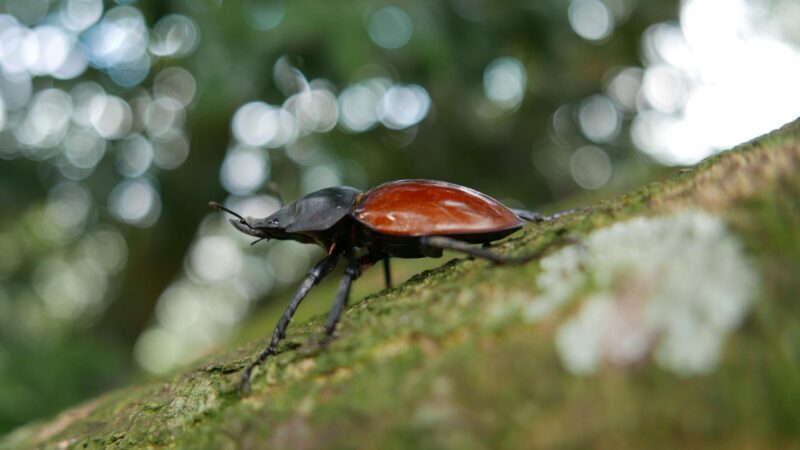
Scientific Name
The scientific name of the beetle is Coleoptera. Currently, there are over 360,000 beetle species in the world, and nearly 30,000 of them are in the United States. Beetles come in different sizes and colors. All beetles have wings, but not all of them can fly. Among those that can fly are carpet beetles and drugstore beetles.
Lifespan
The lifespan of beetles mainly depends on the species and their environment. Most of them can have a life cycle of one year; with adults having the shortest lifespan. Meanwhile, the larval stage has the longest lifespan. Interestingly, wood-boring beetle larvae can live up to 30 years before emerging as adults.
Habitat
The habitat of beetles depends on their species. Although most species live on the ground, some of them are aquatic. Nonetheless, a few of them are exclusively ectoparasitic during their immature stages. Land-based beetles can be found in gardens, vegetation, and deserts. Some species lay eggs indoors.
Diet
Beetles eat a wide variety of food, but most of them are herbivores, eating only plants. This includes fruits, leaves, roots, and flowers. Most adults feed on nectar and pollen, while most larvae feed on seeds, grains, and other dry food products. Dung beetles eat poop. Meanwhile, aquatic beetles eat small fishes and frogs.
Threat
Beetles can bite humans, but they don’t sting and don’t have venom. Their bites can cause redness and swelling but are not dangerous since they don’t transmit diseases to humans. However, flea beetles damage plants, carpet beetle larvae can damage leather and carpets, and flour beetles damage flour and grains.
Control
For outdoor beetle pests such as Japanese beetles, you can pick them up by hand and drop them in soapy water. Alternatively, place Japanese beetle traps in your garden or lawn. To make your lawn less attractive to Japanese beetles, don’t water it during the beetle season, which is roughly from late June to late July.
- JAPANESE BEETLE TRAP: Traps Japanese beetles over a 5,000 square...
- PROTECTS YOUR YARD: Lasts the entire beetle season – helps to...
- DUAL LURE SYSTEM: Natural sex attractant, together with a proven...
- READY TO USE: Just attach the disposable bag to the trap’s...
- CONTAINS: 1 lure, 1 set of interlocking vanes, 2 bags and a hang...
For indoor beetles such as carpet beetles, a few adults may not cause harm. Nevertheless, larvae are likely to be infesting your carpets, upholstered furniture, and dry food products. For washable items, wash them with hot water. Throw away infested food items and place the rest in tightly-sealed jars or containers.
3. Minute Pirate Bugs
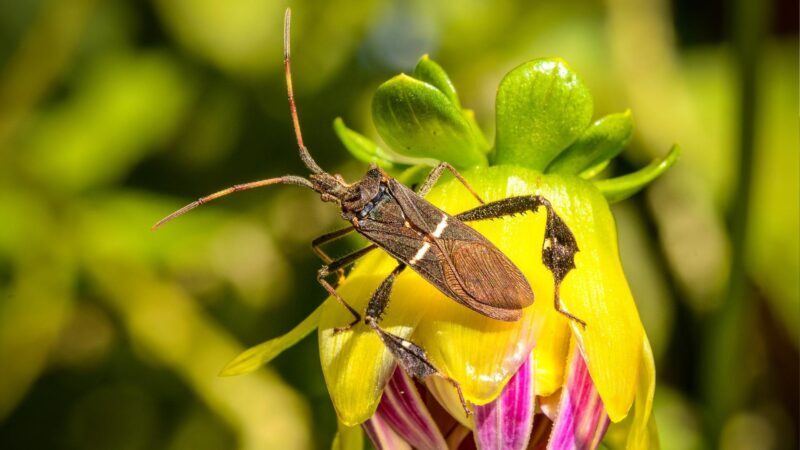
Scientific Name
Minute pirate bugs (genus Orius) are predaceous insects that mostly appear during warmer days. Like their more commonly seen cousin, the insidious flower bug (Orius insidiosus), these black bugs have wings that are longer than their flat, oval bodies. Nonetheless, some of them can have black and white bodies.
Lifespan
Minute pirate bugs undergo incomplete metamorphosis, which means they have three life stages – egg, nymphal, and adult. Eggs hatch between 4 and 5 days, while nymphs go through five nymphal stages that last for 2 to 3 weeks. One complete life cycle typically lasts for 3 weeks, and adults have a lifespan of 3-4 weeks.
Habitat
Minute pirate bugs live in landscapes, gardens, greenhouses, and vegetation. They can be found around ornamental crops and plants such as alfalfa, cotton, orchards, soybean, and wheat. During winter, adults move to sheltered areas such as tree bark and dead leaves. They may also enter houses and buildings.
Diet
Adult and nymph minute pirate bugs are generalist predators. This means that they eat various kinds of pest insects and soft-bodied invertebrates that infest gardens. This includes aphids, caterpillars, leafhoppers, mites, moths, thrips, whiteflies, and insect eggs. If food is scarce, they may feed on pollen or nectar.
Threat
Due to their diet, minute pirate bugs are considered beneficial insects in gardens. In fact, gardeners buy them to help get rid of pest insects. Sad to say, their bites can be painful and itchy, like mosquito bites. Some people may not feel any reaction at all, though. These black bugs don’t sting or carry serious diseases.
Control
Because of their beneficial role in the ecosystem, control of minute pirate bugs is unnecessary and impractical. There is also no proven repellent against them. Their presence usually varies every year, and they are rarely abundant. But to help avoid minute pirate bug bites, wear dark clothes during hotter days or in summer.
4. No-See-Ums
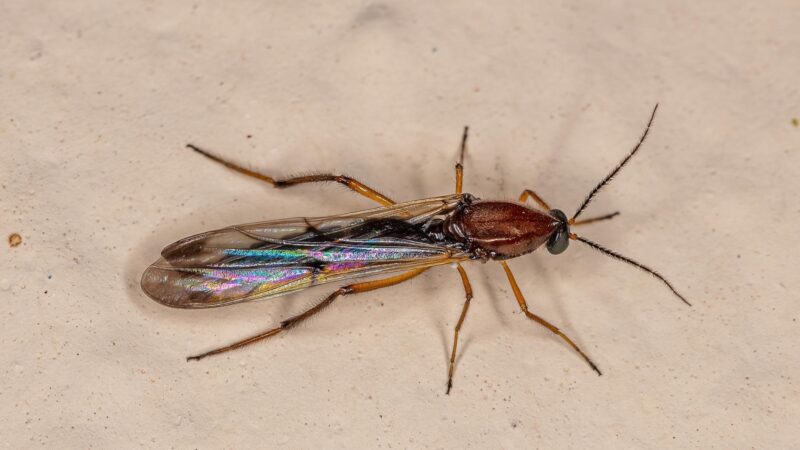
Scientific Name
The scientific name of no-see-ums is Ceratopogonidae. Also known as biting midges, these black bugs with wings are sometimes mistaken for sandflies, which belong to a different insect group. There are more than 4,000 no-see-ums species worldwide, with the genus Culicoides being the most common in North America.
Lifespan
No-see-ums pass through four life stages – egg, larval, pupal, and adult. Eggs hatch within 2-10 days, depending on the temperature. Larvae pass through four larval stages, which usually last from 2 weeks to one year, depending on food sources. Adults emerge in 2-3 days and have a lifespan of 2-7 weeks.
Habitat
The natural habitats of no-see-ums depend on the species. Most of them live in wet, highly organic soil, such as parks, landscapes, and lawns. Some species can be found in the sand, mud, and shores of ponds and lakes. Biting midges are weak flyers and don’t reproduce indoors but can still enter homes and buildings.
Diet
The diets of no-see-ums depend on age, species, and gender. Both males and females feed on plant sap or flower nectar. Females also feed on animal and human blood, so they can reproduce and develop eggs. Males don’t suck blood since their mouthparts are not capable of biting. Larvae feed on small organisms.
Threat
No-see-um bites can be painful and itchy and are more severe than mosquito bites. Although not life-threatening, people beaten by no-see-ums may encounter skin redness and swelling. But then, their bites can cause the Blue Tongue virus in animals. This includes cattle, deer, sheep, birds, and other livestock animals.
Control
Control of no-see-ums is quite challenging since adults are less than 1/8 inches (3.17 mm) long, and larvae are 2-3 mm long. To help repel biting midges, you can use essential oil sprays or DEET-free mosquito sprays that are also labeled for no-see-ums. As a preventive measure, seal all potential entrances to your house.
5. Flying Termites
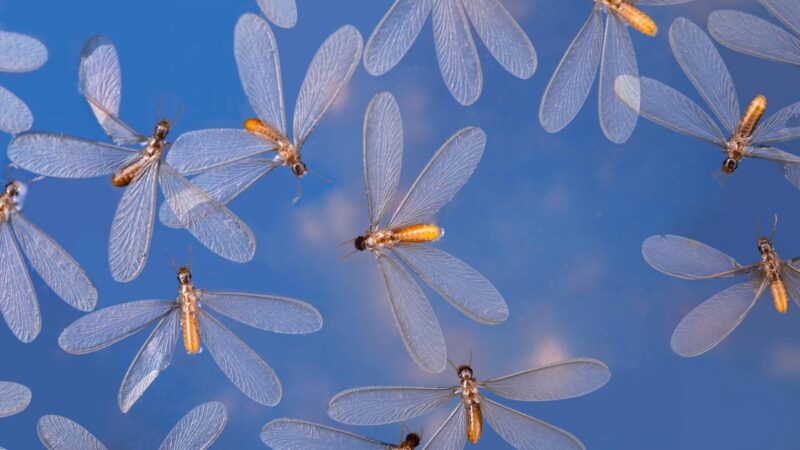
Scientific Name
The scientific name of termites is Isoptera. Technically, flying termites are also ordinary termites, except that they have wings. Also called termite swarmers, winged termites are produced by a termite colony once it reaches maturity, which lasts for 3-5 years. Swarmers shed their wings once they establish a new colony.
Lifespan
Termites undergo incomplete metamorphosis, which means they have three life stages – egg, nymph, and adult. Depending on the species, wingless nymphs molt several times, and worker (and soldier) termites can live for 1-2 years. But amazingly, most termite queens and kings can enjoy a lifespan of up to 25 years!
Habitat
Flying termites can be seen swarming near landscape timbers, tree stumps, and even on windows. On the other contrary, worker termites dig underground dens or live in fallen trees and decaying or dead wood. Subterranean termites build small “mud tubes,” so they can secretly travel from the soil to the foundation of houses.
Diet
Flying termites don’t eat wood until they shed their wings. Meanwhile, worker termites eat cellulose fiber, which is the major component of wood. Once a termite colony is established, these wingless termites go back and forth to their colony to bring food for their king and queen so they can produce more termites.
Threat
Flying termites and the rest of the colony don’t bite, sting, or carry diseases. However, worker termites can cause severe damage to wooden structures such as walls, floors, ceilings, and foundations. Depending on the size of the house and the termite invasion, it may take 3-5 years before damage can be obvious.
Control
The first step to control termites is a thorough inspection. The presence of flying termites suggests that there could be working termites inside or around the house. Once mud tubes are spotted, you may break or open them. However, a dry, empty mud tube does not necessarily mean your house has no termites.
Termites may leave a mud tube to create another one inside the walls. To kill flying termites, use a vacuum cleaner or vinegar solution spray. Yet, it will not solve the problem. To kill worker termites, treat the perimeter of your house with a termite killer. If there is already an infestation, contact a termite exterminator.
6. Flying Ants
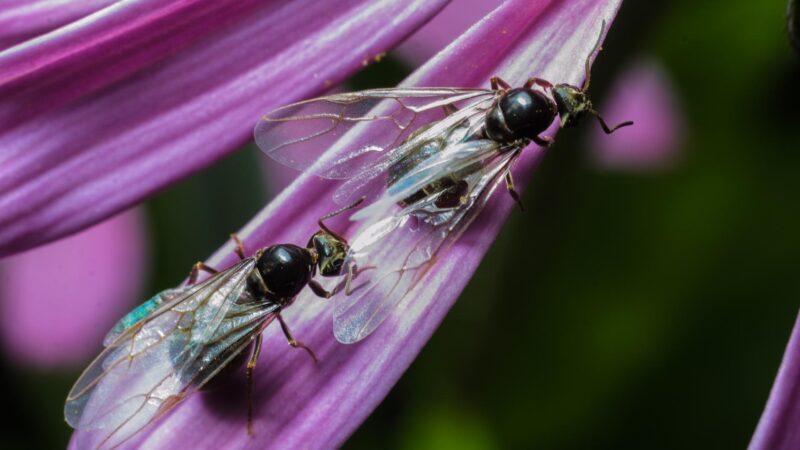
Scientific Name
The scientific name of ants is Formicidae. Flying ants are ants but with wings. There are obvious differences between flying ants and flying termites. The former have bent antennae and front wings longer than their hind wings, while the latter have straight antennae and their front wings and hind wings have equal lengths.
Lifespan
Ants pass through four life stages – egg, larval, pupal, and adult. Their life cycle is usually completed within several weeks to months, depending on the species and the environment. Flying ants shed their wings once they start to build a new colony. Males die shortly after mating, while queen ants live for several years.
Habitat
Flying ants prefer living in urban areas over rural areas and usually appear after a fresh summer rain. They are attracted to light, moisture, and wood. In some cases, these winged ants enter homes but will soon drop their wings. Outdoors, some ant species live in hollow trees and logs, while others build nests in the soil.
Diet
Flying ants don’t eat until they have already started a colony, and worker ants do the foraging for their queen. Ants eat a wide variety of food, depending on the species. This includes cheese, honeydew, fats, meats, starches, and sweet foods, such as peanut butter. They may also feed on nectar and dead insects.
Threat
Flying ants pose no threat to humans and pets. They may bite or sting, but it’s very rare unless they land on the ground and drop their wings. Ants mate while they are flying. So if you will not disturb them, you are likely to be safe. Red ants (fire ants) are more aggressive than black ants, and their bites are more painful.
Control
Ant control depends on the species and the severity of the problem. Ants are considered beneficial outdoors since they are predators of garden pests. They also dig and aerate the soil and create tunnels, thus allowing water to soak into the soil faster and easier. Aside from that, ants help in dispersing seeds in the soil.
Indoors, ants are nuisances and can contaminate food. Since most ants form a line, look for the trails to their nest and block all their entry points. To kill ants on contact, you can use baking soda, borax, Diatomaceous earth, or hot water. Then, remove their food source and always keep your house clean and dry.
7. Fungus Gnats
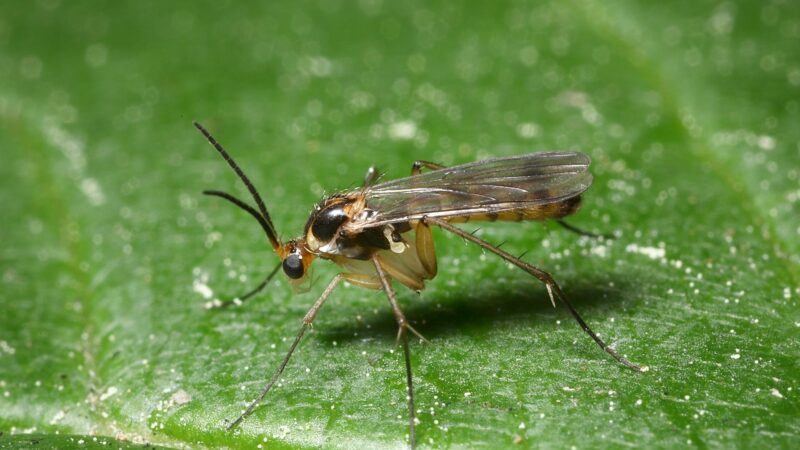
Scientific Name
The scientific name of the fungus gnats is Bradysia coprophila, which belongs to the family Sciaridae. Commonly known as dark-winged fungus gnats, these tiny black flies look like mosquitoes but have a distinct ‘Y’ pattern on their forewings. Adults can fly, but only in short distances and an erratic skipping manner.
Lifespan
Fungus gnats pass through four life stages – egg, larval, pupal, and adult. Eggs usually hatch in 3 days, while larvae develop into pupae from 10 to 14 days. After around 4-7 days, adults will emerge and will have an average lifespan of only 4 days. Hence, fungus gnats have numerous overlapping generations per year.
Habitat
Fungus gnats can survive both indoors and outdoors, as long as there are plants and excessive moisture. They can also be found in greenhouses, nurseries, sod farms, and other areas with rich, organic soil and decaying vegetation. Despite being weak flyers, many adult fungus gnats can be seen flying on windows.
Diet
Adult fungus gnats don’t feed at all but will suck the moisture. On the other hand, larvae eat compost, fungi, grass clippings, leaf mold, root hairs, and organic matter in the soil. They attack both plants in the soil and potted pots indoors. Larvae are usually abundant outdoors during summer but may hitchhike in houseplants.
Threat
Fungus gnats don’t bite, sting, and don’t transmit diseases to humans and pets. But once ignored, a heavy infestation can kill plants. These larvae can cause severe damage to roots and can stunt plant growth, especially seedlings. But in general, fungus gnats are more annoying pests rather than destructive.
Control
Control of fungus gnats should focus more on larvae than on adults. The best way to control fungus gnats is to break their life cycle. Since they thrive in moist areas, the first step to getting rid of larvae is by allowing plants to dry before watering them again. Avoid overwatering them, especially during colder months.
To kill fungus gnats, reduce their water source by clearing up standing water and fixing plumbing leaks. Instead of using garden soil for potted plants, use a potting mix. To control fungus gnat larvae in plants, add some live beneficial nematodes. To kill adults, place No products found. in pots where you see them.
- Can be use around animal, pets and plants
- Each package contains: 5 million Sf ( Steinernema feltiae)
- Release Rate: up to 300 sq.ft. of garden, lawn or soil
8. Drain Flies
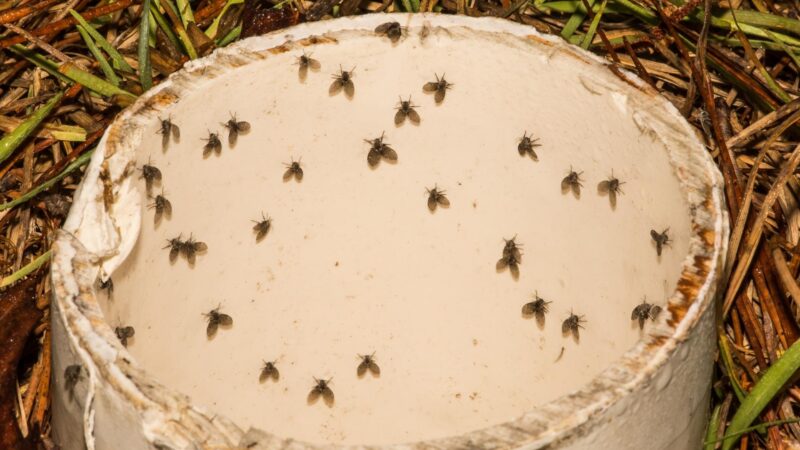
Scientific Name
The scientific name of drain flies is Psychodidae. Also called moth flies, these black bugs have wings that are covered with fine hairs, making them look like moths, hence the name. Their other names include sewer flies, filter flies, and sink flies. There are more than 3,000 drain fly species spread around the world.
Lifespan
Like other fly species, drain flies undergo four life stages – egg, larval, pupal, and adult. Eggs usually hatch in less than 2 days, while larvae mature within 9 to 15 days. Adults emerge from the pupal stage after 1-2 days and will live for only about 2 weeks. The entire life cycle of drain flies can be completed in 1-3 weeks.
Habitat
As the name suggests, drain flies live in drains and sewer systems. Indoors, these nocturnal insects are usually found in sinks, wash basins, bathtubs, bathroom drains and wet floors, toilet tanks, sides of showers, condensate pipes for air conditioners, kitchen grease traps, refrigerator drip pans, and garbage cans.
Diet
Adult drain flies feed on pollen and polluted water. On the other hand, developing larvae eat algae, bacteria, fungi, microorganisms, food waste, and any decaying organic matter in moist environments. If there is a shortage of food, larvae may also eat each other. However, they don’t have mouthparts and teeth to eat solid food.
Threat
Drain flies don’t bite or sting and are not destructive pests. But since they grow in drains and sewers where there could be wet manure, both adults and larvae can transfer pathogens to your food. But so far, there are no reports of serious illnesses due to drain flies. In general, these household pests are only nuisances.
Control
To control drain flies, you should remove their food sources and habitat. To check if a drain has drain flies, remove the drain plate and cover it with a glue board. You can also use a cup wiped with vegetable oil and place it on the drain in an inverted position. The next morning, check if some drain flies are trapped.
Contrary to what many people would think, pouring boiling water or bleach in drains is only a temporary solution. It will kill drain flies but will not remove the organic film within the drain, causing other drain flies to infest the drain. Instead, use a hard bristle brush with a long handle. For better results, use a drain snake.
- Unclog Your Drain in Seconds - Experience the ultimate drain...
- Unmatched Flexibility - This drain snake clog remover is crafted...
- Versatile Drain Cleaner Tool - Whether it's the bathroom,...
- Easy To Use - Unclog sink drain in a breeze with the Zip-It sink...
- Reusable Drain Cleaning Device - This snake drain clog remover is...
Related: How to Get Rid of Drain Flies? | Control Guide
9. Fruit Flies
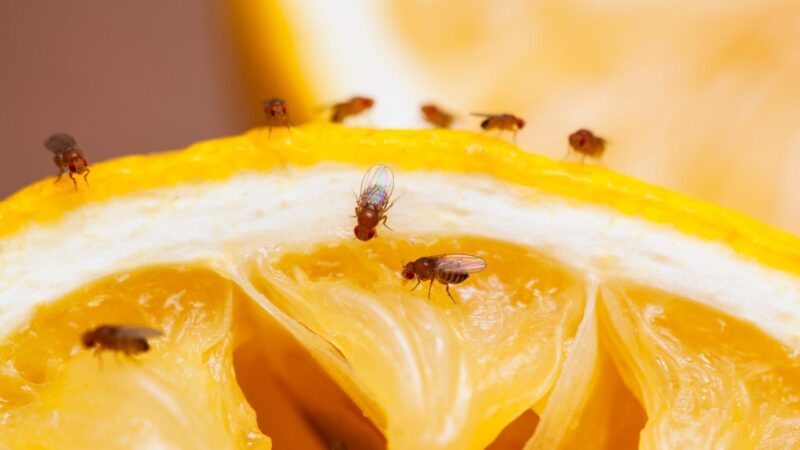
Scientific Name
The scientific name of fruit flies is Drosophila melanogaster. Often referred to as vinegar flies or pomace flies, fruit flies are usually light brown, but some of them are black. Unlike the common housefly, these fly species are not attracted to feces. Nonetheless, they can still be a problem in homes and restaurants all year round.
Lifespan
The lifespan of fruit flies is relatively short, but their reproduction is very quick. Their life cycle from egg to adult is only about a week. Both males and females reach sexual maturity once they are 1 week old, and eggs hatch within 30 hours only. Adult fruit flies have a lifespan of 8-15 days, but some may live up to 40 days.
Habitat
Fruit flies have a wide range of habitats, but are mostly found where there is food preparation or rotting food. This includes restaurants, hotels, cafeterias, grocery stores, supermarkets, fruit stalls, and homes. They may also invade vineyards, orchards, and food processing plants such as canneries, pickle plants, and wineries.
Diet
As the name implies, fruit flies eat fruits, but only the unripened or slightly ripened ones, where eggs are laid. Then, larvae start to eat them until the fruits become rotten. At this point, they are now mature and will soon emerge as adults. Adult fruit flies may also lay eggs on rotting onions, bananas, tomatoes, and melons.
Threat
Fruit flies don’t bite or sting and don’t transmit any diseases to humans. But because of their eating behaviors, they can contaminate food, especially fruits. As we all know, a basket of fruits with a single damaged one can soon damage the others. Yet, fruit flies can also carry bacteria that cause food poisoning.
Control
To help reduce adult fruit flies, you may lure them with bait (rotten fruit or wine) placed inside a jar with a paper cone so they can no longer escape. Alternatively, place fruit fly traps around your basket of fruits. To prevent a fruit fly infestation, throw away rotten fruits right away and clean spilled juice immediately.
- Works Fast – This fast-acting traps eliminate fruit fly...
- Long-Lasting Lure – The ready-to-use, non-staining lure...
- Discreet Design – The attractive, apple-shaped trap design will...
- Monitor Catches – Each fruit fly trap has a built-in window,...
- Locate Breeding Areas – These traps are most effective when...
10. Phorid Flies
Scientific Name
The scientific name of phorid flies is Megaselia scalaris. These bothersome pests are also called scuttle flies, hump-backed flies, and coffin flies. Phorid flies look like fruit flies, except that they lack red eyes and they fly in an erratic manner instead of a straight line. Most of them are black, while some are dark brown.
Lifespan
A female phorid fly lays more than 700 eggs in her lifetime. Eggs hatch within 24 hours, while larvae (also called maggots) mature within 55-65 hours only. The pupal stage is usually about 170 hours, while the total developmental time from egg through pupa is 10-17 days. Adults have an average lifespan of 1-2 months.
Habitat
Phorid flies have a very wide range of habitats but are more common in wet, unsanitized areas. This includes cracked septic tanks, leaky sewerage pipes, dirty food-handling facilities, hospitals, and morgues. In homes, phorid flies are usually found in drain pipes, uncovered trash cans, and even dirty mop heads.
Diet
Phorid flies feed on a variety of decaying organic matter, including decomposing food, fungi, and decaying animal or plant material. They also prey on live insects, such as bumble bees, honey bees, wasps, and fire ants. Some species also eat human corpses and may continue living inside buried coffins, hence the name.
Threat
Adult phorid flies do not bite or sting humans and pets. But since they breed and feed on waste and bacteria, these creepy pests pose serious threats to public health. Larvae infest the wounds of hospital patients and transfer bacteria to them. They may also contaminate food and can cause diseases such as Myiasis.
Control
Phorid fly control should focus on finding and eliminating their breeding sites. Outdoors, inspect your sewer system regularly, and clean your surroundings thoroughly. Indoors, eliminate all sources of excess moisture, food debris, and stagnant, polluted water. To help kill adults, use ready-to-use, disposable fly traps.
- READY TO USE: Bug & Fly Clear Window Traps are waterproof,...
- YEAR ROUND PROTECTION: Catchmaster glue traps are safe, non-toxic...
- HOME & FAMILY SAFE: Designed to help you keep your family...
- TOTAL COVERAGE: This fruit fly killer can be used indoors in...
- INTELLIGENT PEST MANAGEMENT: At our core, we are dedicated pest...
Best Insecticides for Getting Rid of Black Bugs With Wings in Your House
Using insecticides against black bugs with wings in your home is not always recommended. This is because most of them contain chemicals that can harm humans and pets. But then, some situations may require you to use them. To help you out, here are some of the best insecticides that you can try at home.
1. Diatomaceous Earth (DE)
Diatomaceous earth has two main types – food grade and filter grade. Although both of them can be used as insecticides, filter-grade DEs has higher levels of crystalline silica and is toxic to humans. Pest bugs don’t need to eat DE to be killed. It kills them by breaking their exoskeleton, causing them to dry out and die.
- VERSATILE APPLICATION: Suitable for indoor and outdoor use, apply...
- ORGANIC GARDEN COMPLIANT: OMRI Listed for compliant use in...
- SAY GOODBYE TO BUGS: Kill a wide range of crawling insects like...
- DEHYDRATES AND KILLS: Our diatomaceous earth, combined with...
- NON-STAINING AND ODORLESS: Confidently use our bedbug killer and...
2. Boric Acid
The boric acid powder is another effective insecticide against black bugs with wings and insects. Boric acid kills bugs in two ways – by poisoning their stomach and by damaging their exoskeleton. Although less toxic than DE, you should still be very careful. Boric acid can also kill plants, so be careful when using it in your garden.
- Industrial grade strength
- 99.9+ percent pure
- Anhydrous (without water)
- High quality boric acid
- Powder form
3. Pyrethrin-based Insecticides
Most pyrethrin-based insecticides, such as Ortho Home Defense Insect Killer, can be used indoors and outdoors. They don’t only kill bugs on contact but also serve as a barrier to prevent these pests from invading your home. But like other insecticides, they can be harmful to humans. Follow label instructions religiously.
- Ortho Home Defense Insect Killer for Indoor & Perimeter2 is a bug...
- Provides a long-lasting bug barrier of up to 12 month protection...
- Apply this pesticide anytime as a preventative treatment or after...
- Use this pest control spray with confidence indoors (kitchens,...
- The easy-to-use continuous spray Comfort Wand helps you control...
Using insecticides indoors should be your last resort. To avoid infestations, you should act as early as possible once you see signs of black bugs. Killing them is also not enough, as these house pests may come back in their next breeding season. So far, the best preventive measure is not to give them reasons to enter.
List of Sources
Structure-Infesting Wood-Boring Beetles








